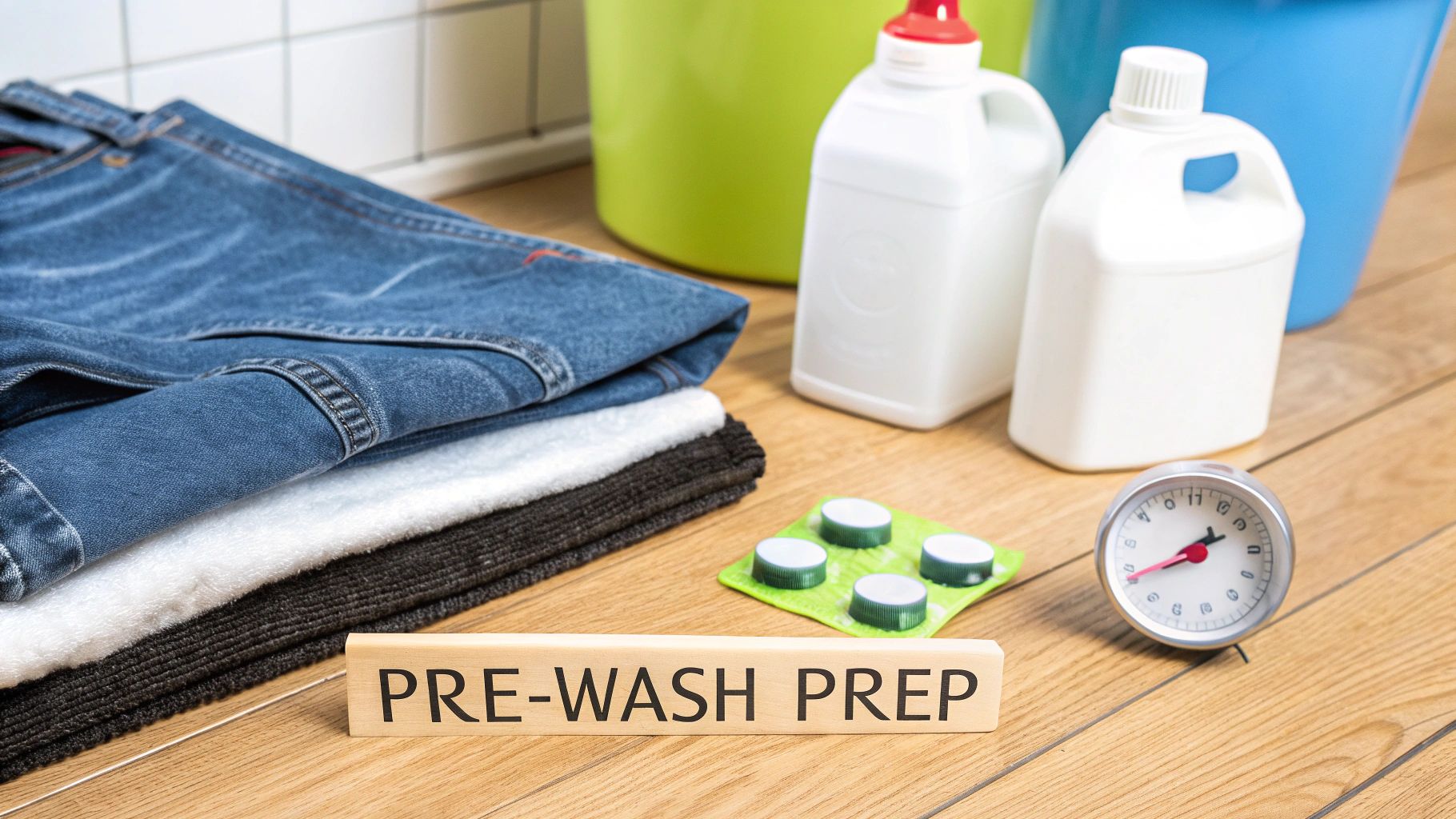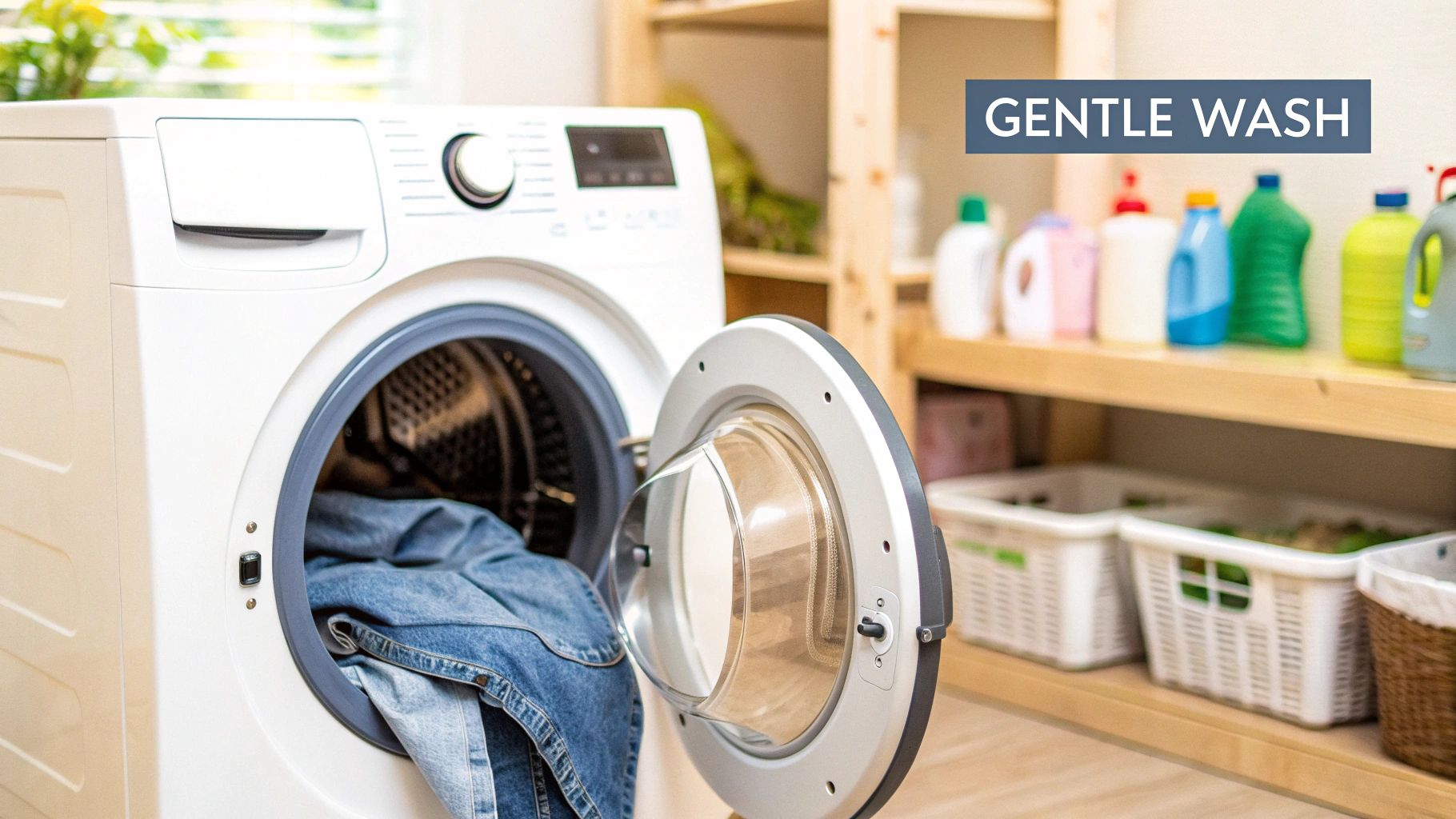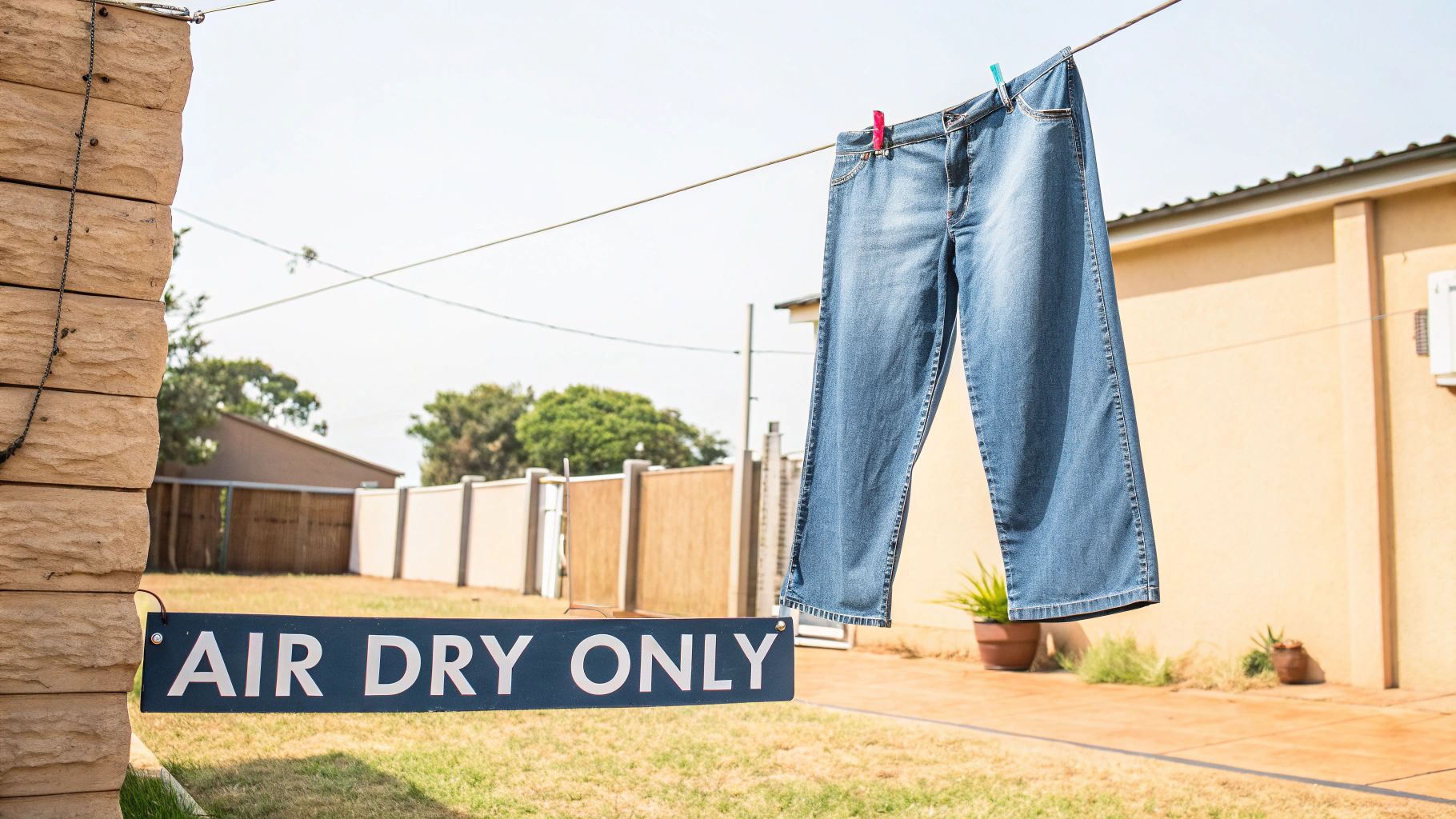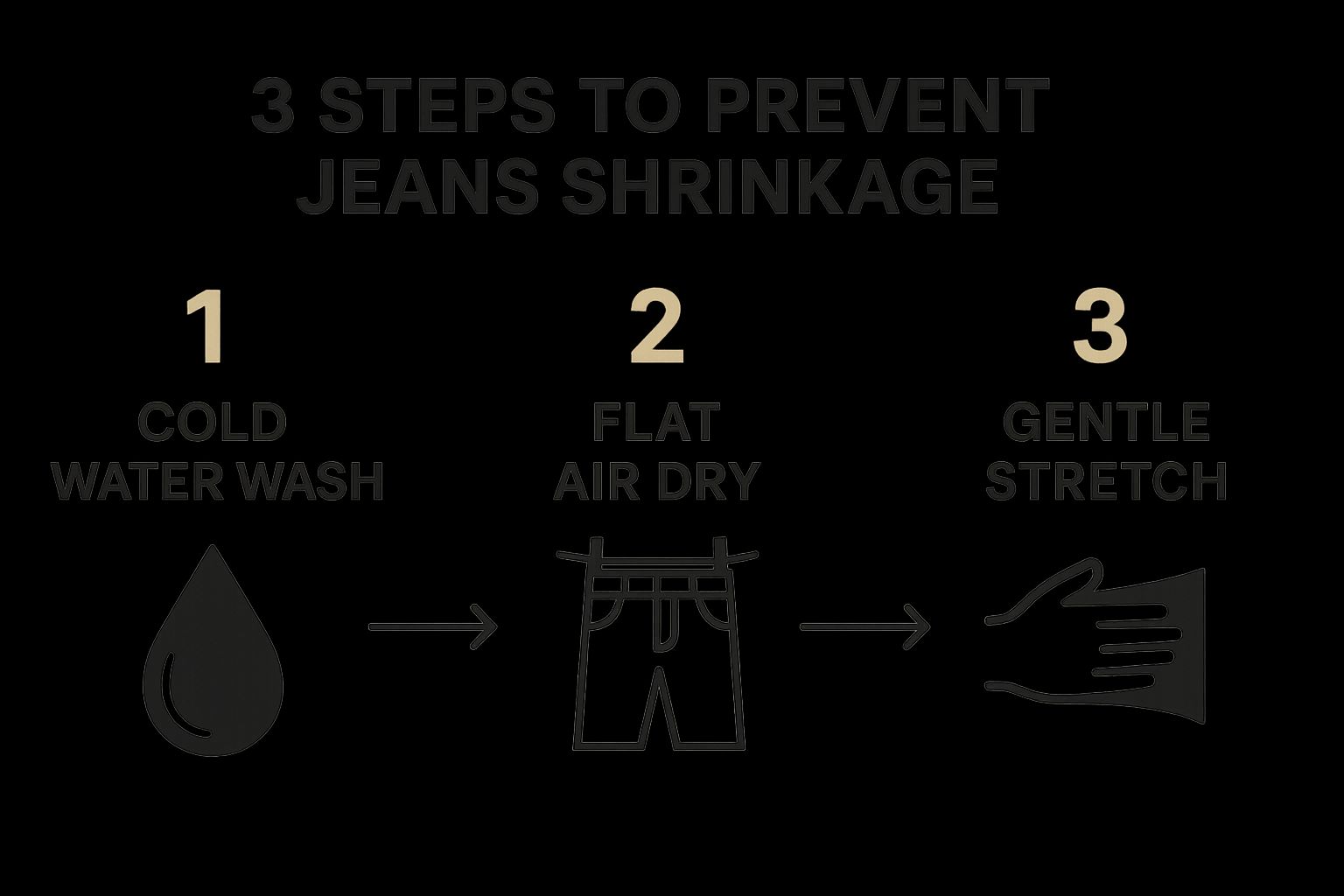
How to Keep Jeans from Shrinking: Tips & Tricks
We’ve all been there. You pull your favorite pair of jeans from the laundry, fresh and clean, only to find they’ve mysteriously become a size too small. It’s a frustratingly common problem, but it’s not just in your head. The reason this happens is simple: the cotton fibers in denim naturally contract when they meet heat and water.
Understanding this 'why' is the first real step to mastering the 'how' of keeping your jeans fitting perfectly, wash after wash.
Why Your Favorite Jeans Keep Shrinking
That dreaded moment when you discover your go-to jeans are suddenly uncomfortably snug is almost a rite of passage. The science behind it is pretty straightforward. Denim is, at its heart, a woven cotton fabric. When you introduce those natural cotton fibers to a cocktail of hot water and high dryer heat, they first relax and then pull tight, causing the entire garment to shrink.
This isn't just a minor annoyance; it's a huge deal for denim lovers. The data shows just how much shrinkage affects our relationship with our clothes.
In fact, a surprising 22% of customer complaints about jeans are directly tied to shrinking. This has a real ripple effect, with over half of shoppers reporting that their clothes, jeans included, just don't last as long as they used to. You can dig deeper into how fabric quality shapes what people buy in this denim demand report.
The Role of Fabric and Heat
At the end of the day, the two main villains are heat and agitation. The rough-and-tumble environment of a washing machine, especially with hot water, puts a lot of stress on those cotton fibers. Then, the intense blast of hot air from the dryer acts like a final seal, locking them into that newly shrunken state.
While many modern jeans blend in synthetics like elastane or polyester for better stretch and shape retention, classic 100% cotton denim is the most susceptible to this shrinkage.
- Heat: This is what makes the individual cotton fibers physically contract.
- Moisture: Water causes the fibers to swell up, and as they dry, they tighten.
- Agitation: The mechanical tumbling of a washer can literally compact the fabric's weave, making it denser and smaller.
Investing in high-quality denim is a fantastic start, but even the best-made jeans need a little TLC to maintain their original fit and feel. Building a solid rotation of denim you can count on is so much easier when you know how to protect your investment. It's the same core idea behind creating a timeless, functional wardrobe. For more on that, take a look at our guide to building a capsule wardrobe with jeans over 40.
Once you know that heat is the enemy, you can start using simple, effective tricks to prevent shrinkage for good.
A Better Way to Wash Your Jeans

The real secret to keeping your jeans from shrinking isn't some complicated magic trick. It's actually a pretty simple process that starts long before you even think about pressing "start" on your washing machine. Honestly, using the right washing technique is your best defense against that dreaded, too-tight feeling after laundry day.
Before your denim even gets near the water, a little prep work can make all the difference. I always make a point to turn my jeans inside out. It's a small step, but it protects the outside of the fabric from the friction of the wash cycle, which goes a long way in preserving both the color and the feel of the denim. Also, make sure to zip up any zippers and unbutton all the buttons. This keeps them from snagging on other clothes and helps your jeans hold their shape.
Choose Your Method: Machine vs Hand Wash
For most modern denim, especially pairs with a bit of stretch, a washing machine is totally fine as long as you use the right settings. But for raw denim or that one special pair you're incredibly protective of, hand-washing is the way to go. It gives you complete control and is much gentler, avoiding the intense spinning that can really stress out cotton fibers.
No matter which method you land on, the most important factor is the water temperature. Heat is, without a doubt, the number one enemy of cotton.
Key Takeaway: Cold water is your absolute best friend for preventing shrinkage. It’s so much gentler on the fabric than warm or hot water, helping to maintain not just the fit but also the color and integrity of your denim for years to come.
When you're using a machine, always opt for the gentle or delicates cycle. This setting cuts back on the agitation and spin speed, basically mimicking the less stressful environment of a hand wash. Pair this with a mild, color-safe detergent to keep the dye from fading. If you want to dive a bit deeper, this article on how to wash jeans has some fantastic extra tips.
To really see the difference, let’s break down how water temperature impacts your jeans.
Washing Method Comparison: Cold vs. Hot Water
This quick table shows why we always recommend sticking with cold water. The difference in outcome is pretty stark.
| Factor | Cold Water Wash (Recommended) | Hot Water Wash (Not Recommended) |
|---|---|---|
| Shrinkage Risk | Low; helps maintain original size. | High; causes cotton fibers to contract significantly. |
| Color Retention | Excellent; prevents dye from bleeding and fading. | Poor; strips color and can lead to a dull look. |
| Fabric Integrity | Gentle; preserves the strength of the denim fibers. | Harsh; weakens fibers over time, leading to wear. |
| Energy Use | Low; more environmentally friendly and cost-effective. | High; requires more energy to heat the water. |
At the end of the day, just treating your laundry with a little more care is the key. By prepping your jeans properly and committing to a cold, gentle cycle, you're actively stopping shrinkage before it even has a chance to start. Your favorite pair will thank you by fitting perfectly for a long, long time.
Mastering the Art of Air-Drying Denim
 After all that care in the wash cycle, the last thing you want to do is ruin your efforts with a blast of heat. Your dryer is the number one enemy of well-fitting jeans. That intense, tumbling heat is what locks in shrinkage.
After all that care in the wash cycle, the last thing you want to do is ruin your efforts with a blast of heat. Your dryer is the number one enemy of well-fitting jeans. That intense, tumbling heat is what locks in shrinkage.
To truly keep your jeans from shrinking, you have to embrace the art of air-drying. This simple, heat-free method is hands-down the most effective way to protect the fit and feel of your denim. It lets the cotton fibers dry out slowly and naturally, preventing that sudden contraction that makes them too snug.
The Best Way to Air-Dry Jeans
For the best results, pull your jeans from the washer and hang them up right away. I’ve found the ideal method is to hang them by the belt loops using a sturdy hanger. The weight of the damp denim gently pulls the fabric straight, which helps smooth out weird creases and lets air circulate around the entire garment.
While they're still damp, take a second to reshape them. I always run my hands down the legs and give the waistband a gentle tug to make sure they dry in their original form.
Expert Tip: Try to avoid hanging your jeans in direct, harsh sunlight. While the warmth might seem helpful, prolonged UV exposure can cause that beautiful indigo dye to fade unevenly, especially on your favorite dark-wash pairs. A well-ventilated room or a shady spot on the porch is perfect.
Using a Machine as a Last Resort
Look, life gets busy. Sometimes you just don’t have the time or space to air-dry. If you absolutely must use a machine, there’s a safer way to do it.
Just be sure to select the ‘no heat’ or ‘air fluff’ setting on your dryer. This simply tumbles the jeans with room-temperature air, which helps soften them up without the damaging heat that causes shrinkage.
If you go this route, follow these key steps for safer machine drying:
- Use the Air-Fluff Setting: Never, ever use a cycle with any level of heat.
- Add Dryer Balls: A few wool or rubber dryer balls can help speed things up and soften the fabric.
- Remove While Damp: This is the golden rule. Pull your jeans out while they are still slightly damp to the touch. Then, just hang them or lay them flat to finish drying completely.
This hybrid approach gives you a bit of modern convenience without totally sacrificing the fit of your favorite pair of jeans.
How to Buy Shrink-Resistant Jeans

The best way to stop your jeans from shrinking isn't some laundry room secret—it starts the moment you decide to buy them. Think of it as a pre-emptive strike. Your first line of defense is becoming fluent in the language of fabric labels.
We all love the classic, rugged feel of 100% cotton denim, but it's also the most notorious for shrinking. A smarter move is to look for jeans with a modern blend. When you see materials like polyester, Lycra, or elastane woven in with the cotton, you've found a pair with built-in stability. These synthetic fibers don't react to heat the way pure cotton does, helping your jeans snap right back to their original shape after a wash. It’s how you preserve that perfect fit you found in the dressing room.
Look for Pre-Shrunk Denim
Another term to keep an eye out for on the tag is "sanforized" or "pre-shrunk." This is a game-changer. It means the denim fabric has already been put through a controlled shrinking process before it was even cut and sewn.
While a pre-shrunk pair might still shrink a tiny bit—we're talking maybe 1%—it’s nothing compared to the potential 5-10% shrinkage you could see with untreated or raw "shrink-to-fit" denim.
Choosing pre-shrunk denim is your safest bet for a predictable fit. It takes all the guesswork out of laundry day and ensures the size you buy is the size you get to keep.
As brands get more innovative, shrink-resistance has become a huge selling point. The global denim market is on track to grow significantly, and designers know that customer loyalty comes from delivering jeans that look and feel great wash after wash.
Investing in jeans made from these more stable fabrics will save you so much frustration (and money) down the road. Understanding the material is just as important as the cut and style. To bring it all together, our comprehensive jeans fit guide can help you find your forever pair.
A Rescue Plan for Shrunken Jeans
It’s that sinking feeling. You pull your favorite jeans from the laundry, and they suddenly look like they belong to a smaller sibling. Don't panic. Before you mourn their loss or banish them to the back of your closet, there’s a rescue mission you can try.
Think of it as first aid for your denim. The best approach I've found is the "wet stretch" method, and it works wonders. You’ll want to find a tub or a clean sink and fill it with lukewarm water. Hot water is the enemy here, so keep it cool. Add a small dollop of something that will relax the cotton fibers—hair conditioner or even gentle baby shampoo works beautifully.
Submerge your shrunken jeans completely and let them soak for at least 30 minutes. This gives the conditioner time to work its magic, softening up the stiff, constricted denim.
The Gentle Stretch and Reshape
After they've had a good soak, it's time to get the excess water out. Gently press the water from the fabric. The golden rule here is to never twist or wring them out aggressively. Doing so can stretch and break the delicate cotton fibers, causing permanent damage.
Once you’ve pressed out most of the water, lay them flat on a large, clean towel on the floor. Now comes the hands-on part. Gently pull and stretch the fabric back into shape, focusing on the areas that feel the tightest—usually the waistband, thighs, and inseam. Work your way around the garment, pulling slowly but firmly. When you’re satisfied, hang them up to air-dry, making sure to keep them away from direct sunlight or any heat source.
This handy visual guide breaks down the core principles for preventing this whole ordeal in the first place. It all comes down to cold washing and air drying.

Ultimately, a gentle, heat-free approach is your best defense for preserving the original fit and feel of your denim.
This isn’t just a personal frustration; it’s a massive issue for the retail world, too. Shrinkage accounts for a staggering 1.82% of annual retail sales losses across the globe. For clothing brands where fit is paramount, this problem leads directly to more returns and disappointed customers. You can dive deeper into this global issue in the Sensormatic Shrink Index report.
Answering Your Biggest Jean Care Questions
https://www.youtube.com/embed/ghZh2P_NSmA
Even when you've mastered the basics of washing and drying, some questions always seem to linger. Let's clear up some of the most common denim dilemmas we hear about all the time.
How Often Should I Really Wash My Jeans?
Honestly? As little as humanly possible. This is the one question we get more than any other, and the answer surprises people.
Over-washing is the number one enemy of a great pair of jeans. It's the fast track to fading, wear and tear, and yes, shrinking. Unless your jeans are visibly dirty or starting to smell, try to get several wears out of them between washes. Spot cleaning little spills is your best friend here—it keeps them looking fresh without a full-on machine cycle.
Do Household Hacks Actually Prevent Shrinking?
You've probably seen the tips floating around: add a splash of vinegar or a handful of salt to the wash to stop your jeans from shrinking. So, does it work?
The Verdict: While these kitchen staples are brilliant for setting dye and keeping your denim's color rich, they won't do a thing to prevent shrinkage. Shrinking happens when cotton fibers react to heat and friction—it's a physical process that vinegar and salt just can't touch.
If you're looking to protect that perfect wash, our guide on how to keep jeans from fading has some fantastic tips.
Do Darker Jeans Shrink More?
It's a common belief that dark-wash jeans are more likely to shrink than their lighter counterparts. While the color of the dye itself doesn't make a difference, there's some truth to this.
Darker, raw denim is often less processed than pre-faded or distressed styles. This means the cotton fibers haven't been subjected to as much washing and treatment, so they have more "shrink potential" left in them. Your first wash with a dark, rigid pair is always the most critical.
Proper storage is another piece of the puzzle. For those pairs you don't wear all the time, folding them neatly and following some simple long-term clothing storage best practices can help them keep their shape beautifully. At the end of the day, consistent, gentle care is what gives your favorite denim a long and happy life.
At JAG Jeans, we design denim that combines timeless style with incredible comfort, so you can feel confident and look great wash after wash. Discover your perfect fit today.